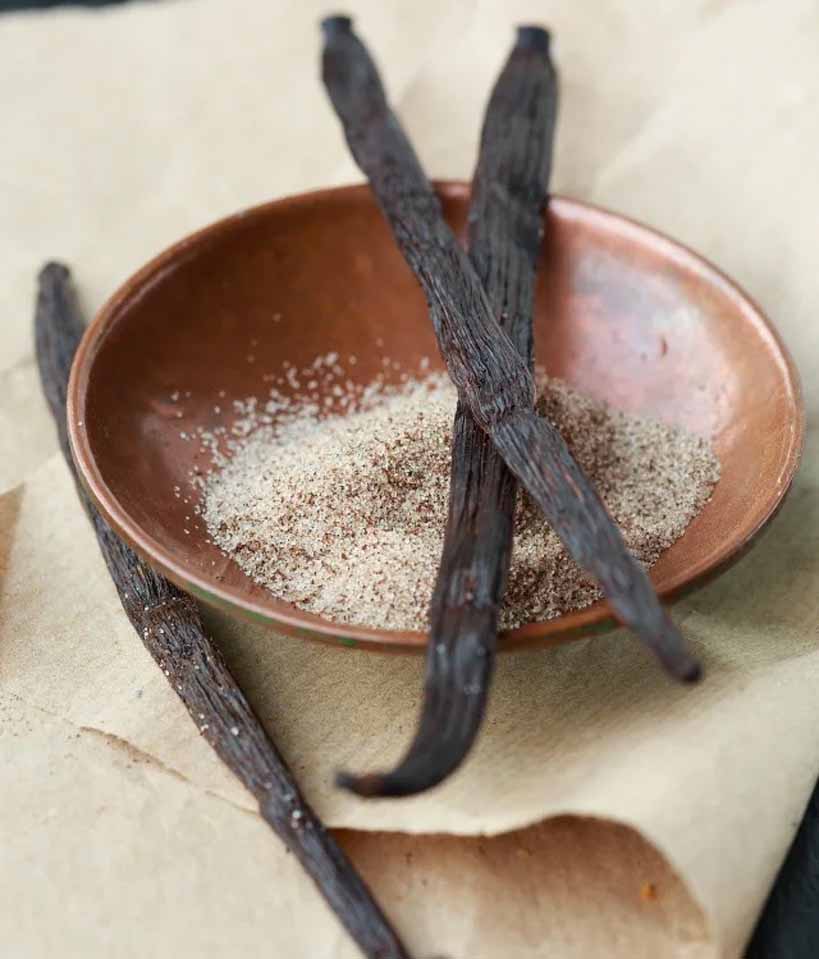This is the first of many posts about our journey through the world of vanilla beans. This post tells the story of ditching the tried and true path of sourcing vanilla beans and how and why we decided to go directly to the farmers.
When we bought SpiceTopia in October of 2019, SpiceTopia’s vanilla was sourced through a large co-op that offered FairTrade Certified beans. Unfortunately their supply was limited and just when everyone was baking for the holidays, we ran out of beans and couldn’t get any more FairTrade Certified beans. After that holiday season, we knew we had to do something different to source our beans. So our journey into the world of vanilla beans began!
Of course, we knew the basics or thought we did!
FairTrade Madagascar Bourbon beans are the ultimate bean, right? Well kinda and sometimes!
Vanilla beans are originally from Mexico, but are now grown around the world in climates where the weather is consistently warm and humid with regular rainfall throughout most of the year. Vanilla grows well in many locales, but outside of Mexico those locales are missing one key component needed to produce our beloved vanilla beans–orchard bees! That means vanilla beans coming from anywhere outside of Mexico need to be pollinated by hand. A vanilla orchid flower blooms for just one day and so has an extremely limited time to be pollinated. After the beans are picked, the curing process of vanilla beans can take 6-9 months of daily attention. This means many vanilla farms have high rates of child labor. This is why we were determined to only source FairTrade Certified beans.
And then we attended the Fancy Food Show in February of 2020 and were able to connect with other spice store owners who traveled directly to farms to source their spices. That was when we learned that FairTrade Certification and sourcing is not so straightforward as we thought.
The Vanilla Bean industry is small compared to most other crops. In a year with optimal weather conditions, the worldwide production of vanilla beans is only about 2,500 tons. Compared to the 4.7 million tons of worldwide annual production of chocolate, vanilla farmers’ production is miniscule. Most vanilla is produced on farms smaller than 2 acres. And what does this have to do with fairtrade? It means that vanilla production is not a focus of FairTrade organizations. As non-profit organizations, FairTrade Certification programs must focus their energy where it goes the furthest and that isn’t always for small producers like vanilla farmers. As well, the inspections and certifications needed for this certification can be too expensive for small scale farmers. Hence the difficulty in finding FairTrade Certified beans. Most FairTrade Certified vanilla beans come from a few large vanilla farms that are owned by corporations rather than individual farmers. While these farms do provide much needed jobs for locals, they do not support small-scale entrepreneurs/farmers.
So where did this leave us in sourcing beans?
Well, we began to think about how we could get fairly traded beans that weren’t necessarily FairTrade Certified. After thinking about how we source our local products, we realized eliminating layers was important. Locally, we know our producers. Come into our store and ask us about our hot sauces or chutneys or honeys. We’ve met our producers and know the stories behind the products we sell. Delonne produces his Fairy Blood right down the street from SpiceTopia. Blue Ridge Honey invited us into their facilities and we know where their bees and hives are hanging out. Uncle Tim of Uncle Tim’s pickles grows his own produce right in Oxnard just a few miles from SpiceTopia’s shop. So how can we get closer to that model with food grown on the other side of the world?
Someday we hope to be able to travel to visit our spice and tea producers. Until that time, we are working with an agent who has direct relationships with farmers around the world. She is helping us bridge the communication issues that come with working with farmers who do not share a common language with us. This relationship eliminates many of the layers–processors, exporters, importers, distributors, and wholesalers–between us and the vanilla farmer. Our agent communicates with farmers to discuss what is available and is able to help us place orders. The beans then come directly from the farmer to us! And the farmer receives much more of the profit for their beans, then when we were utilizing the FairTrade Certified system. After many conversations and much research, we are confident in our agent’s relationships and judgement of how the farmers are producing their beans. We are excited about this direct ethical sourcing model.
This does mean we have to carefully plan ahead to always have vanilla beans and that’s something we are working on figuring out. No more calling up our sales rep and letting her know we need 8 oz of beans next week. Now we let our farmer know how much of their harvest we are committing to buying, and we pay for the beans months ahead of when we receive them.
So far two different batches of beans have arrived, and we are extremely excited with their quality! Our first batch is from Madagascar and is so much more fresh, fragrant, and plump then the Madagascar beans we’ve had in the past! Our second batch is from Papua New Guinea and are beautiful as well. Though the two beans are the same variety, it is interesting to experience the different taste and aromas that come from these different locations.
What that means for you?
More beans! And different kinds of beans! Stay tuned for our next post on the different varieties of beans we hope to order throughout the next year!
Vanilla Bean Extract Class
And if you’d like to experience these beans for yourself, sign up for our Vanilla Bean Extract Class! We will be using both types of beans to make extract perfect for gift-giving!



